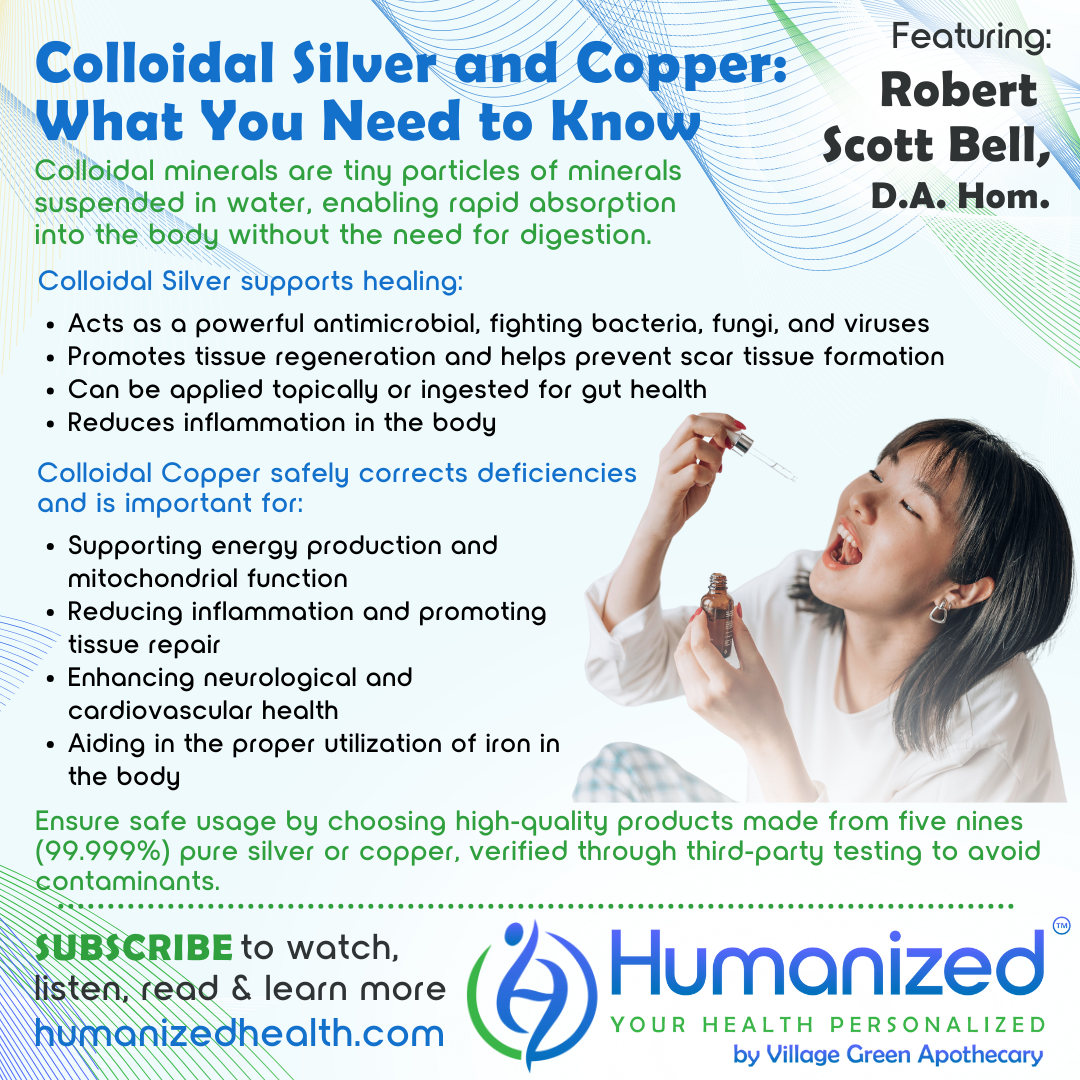Colloidal Silver and Copper: What You Need to Know
Featuring
Robert Scott Bell, D.A., Hom.
WATCH
LISTEN
READ
Rebekah Kelley: Welcome to the Humanized Podcast, all about personalizing your health. I’m your host, Rebekah Kelley. And today our topic will be “Colloidal Silver and Copper: What You Need to Know” with Robert Scott Bell. Before I introduce Robert, I want to remind everyone to subscribe and get all the other casts and audio video and transcription at HumanizedHealth.com. I’d also like to thank our lead sponsor Village Green Apothecary at MyVillageGreen.com.
A little bit about Robert Scott Bell–he is a homeopathic practitioner and author and an expert in silver and copper therapeutics. As a keynote speaker, lecturer and educator, he shares his expertise and practical experience with a broad range of audiences from Health Care and wellness professional forums, to Natural Industry trade and consumer shows, addressing those who are seeking the depth of his knowledge, education and key insights from his years of holistic practice, supporting effective natural health and healing choices. Robert reversed numerous chronic diseases, nearly 30 years ago via homeopathy, herbal medicine, organic whole foods, minerals, essential fats and the transformational power of belief in the divine spirit.
Robert, thanks for being with us.
Robert Scott Bell: Thanks, Rebecca. Great to be here to share some good healing news.
Rebekah Kelley: Wonderful. So let’s just jump right in. We know that mineral forms are important for assimilation. But let’s just start with the basics–can you explain what a colloidal mineral is?
Robert Scott Bell: Well, basically it’s a mineral in suspension in water and usually in a very small size.
So when we look at the blood, the blood is a colloid. There are things in blood that are in suspension, not necessarily dissolved into it. So you have typically a 360 degree interaction with whatever is in suspension. And it doesn’t require digestive breakdown for access to minerals in colloidal suspension. So it kind of bypasses a lot of weakness that is, unfortunately, inherent to so many in the western world that have been raised on horrible food and been destroyed by antibiotics and decimated their microbiomes, etc. So it’s kind of a leg up to get certain key minerals in, in a very quick and rapid way, as well as learning the properties of the minerals you might put in colloidal suspension. You might have other reasons for ingesting it or utilizing it topically.
Rebekah Kelley: So we’re told that silver can be a toxic metal and I’ve certainly seen those pictures of those blue people, right? What are the benefits of colloidal silver and is it safe?
Robert Scott Bell: Yeah, silver, interesting as a metal, I was very reluctant to begin using it in my homeopathic practice until I read the book by Dr. Robert Becker called “The Body Electric,” and I realized that silver, more than being a broad spectrum antimicrobial, which most people are aware of it– it can eradicate bacterial species, fungal species, and even stop viral replication for those that are concerned there. But it has more importantly, I think, a role in delivery to the area in need when there’s inflammation or cytokine storms or responses, like due to injury, infection, wounds, things like that.
So if you apply silver into those areas, you start a process of cooling the inflammatory response, not by suppression, so there’s no harm, but upregulating a process of dedifferentiation and redifferentiation, so stem cell acceleration. So you replace the cells in a healthy manner and you reduce the potential for scar tissue formation locally. Now, that can be done topically or it can be done through driving into the gut with aloe vera juice, this is a protocol I developed many years ago with many physicians to help heal the guts of so many that were so, so severely injured by antibiotics and now pesticides, glyphosate, et cetera, that they were on the road to surgical interventions. Right, people with colitis and Crohn’s and diverticulitis, things like that. So driving silver into the point of foci epithelial inflammation, we could cool that inflammation safely and upregulate regeneration. So other protocols will be enhanced by that because silver at the level of a colloid or a bioactive silver hydrosol has immediate interaction with no toxicity, and the body can then easily excrete it by the liver, the phase two conjugation pathway, selenium dependent sulfur, sulfhydryl groups that eliminate it. Even if you drink it as a colloid, it’s still silver in the water, then it’s removed as a solid waste, usually within 24 hours or less.
Rebekah Kelley: So what is a colloidal copper? Why is colloidal copper becoming so popular?
Robert Scott Bell: Well, the copper issue is a big one. It became much more prevalent in concerns during the COVID years we’ve been through. Because a lot of even physicians were administering high doses of zinc and vitamin C. And both of those deplete copper in the body. And most people aren’t eating copper rich foods, which primarily historically were known like the organ meats, like liver. How many of you know anybody that eats liver at all, much less regularly? And we know that the digestive processes are not super efficient in breaking down to absorb copper from food, maybe 30 to 40 percent, if you have good digestion.
So we have a lot of deficiencies. The depletion of the soils due to modern chemical agriculture has been legendary in diminishing soil content of minerals, except for what they add, like NPK. But copper, on the list of reduction of soil presence, the worst–70 to 80% reduction since they started chemical agriculture and monocropping. So we are in a great deficit, and so, I want to get it in fast in that colloidal or bioactive silver or copper, in this case copper hydrosol state, we can immediately bring the active and available–we call it bioactive and bioavailable form of copper–that doesn’t require breakdown. The moment it hits the mucosa or anything in the GI tract, it’s in. Nothing’s wasted and we can take a fraction of the amount of copper we would normally need to get to get the little benefit. We take a little and get a lot of benefit and never risk taking too much.
So utilizing the Sovereign Copper that I recommend is a tablespoon, it’s 150 micrograms. So even if you did three tablespoons a day, you’re meeting the needs of a four year old. So you can see that’s safety, right? But we have an ability to use far less copper in that context to get far greater benefit. This is kind of a homeopathic perspective. Use a little, get a lot, instead of use a lot and get toxic, right, whether it’s silver, copper or otherwise. So it’s a wonderful way to introduce copper back into the system, get people back on track because copper manages inflammation response systemically.
So many pathways are relying on copper––they’re called cuproenzyme pathways––including energy production at the mitochondrial level, ATP, that’s magnesium and copper primarily. If we talk about its antioxidant role, copper also is an anti-parasitic, natural anti-parasitic, interestingly enough. And it facilitates against so many neurological processes, including regular heart, people with what we call seizure disorders, children especially, often have copper deficiencies. So there’s so much that we can cover. I don’t know how far you want to go, but copper is a huge thing and unfortunately wrongly maligned and we’re told to fear it.
Rebekah Kelley: I know that whenever I was seeing a nutritionist, I needed copper and she suggested having cocoa powder, which I did enjoy, but there’s only so much cocoa powder you can actually do. So it actually sounds like your suggestion actually could be much more effective.
How can we identify, then, properly made colloidals? Because that’s the other concern I know that I’ve heard is that you just want to make sure that you’re getting something that is from a trusted source. How do you know whether something’s a trusted source? I know you’re an expert, I think you’re on the board, right? Can you just give us a little bit of experience? Because I know you actually know a lot about it. And then where, where should we go?
Robert Scott Bell: Yeah, I serve on the board of Trinity School of Natural Health. Also I served at one point some years ago on the American Association of Homeopathic Pharmacists board and also now on the United Precious Metals Association because we work with all these noble metals as money too, not just nutrients and minerals.
Rebekah Kelley: Right, so you know a lot of history? A lot of background in this?
Robert Scott Bell: Yeah, there’s a lot of use not just for body and health. But you know, copper and silver, it’s kind of a blind item when it’s in a colloidal state, it’ll look like water for the most part. And so to analyze this under electron microscopy is fascinating. You can take a drop of it and you can see the dispersion, what it looks like as far as what we call the speciation of the metals. First of all, you want to use five nines pure silver or five nines pure copper. You don’t want four or three nines because then you’ll have base metal contaminants that don’t belong there.
Then, of course, a pharmaceutical grade purified water, something that is so pure there’s nothing else that causes it to agglomerate or compound to make it less available for the body, bioactivity. And so, analyzing through transmission electron microscope allows us to see the purity as well. And there are other analytical tests, but in that way, it’s a visual, it’s a powerful reference that we can see these images 100,000, 110,000 times magnified. We’re like, wow, that’s where the body’s interacting with it. Otherwise, you have a lot of, you know, just statements of claims that are not validated. They sound great for marketing purposes. So, I always ask, you know, third party validation or regular validation by some way that you can know they are indeed using, what, five nines pure to start, as well as what does it end up as? What does it look like? Is it bound? Are there stabilizers? Are there inadvertent contaminants because they package it in plastic instead of glass, right? These are real issues. And then you can know, safety is something of paramount concern for me because I detoxify patients of heavy metals, kids too, and to work with copper and silver which are, I believe, beneficial, I think essential even though they haven’t established that for silver they have for copper. I want the form that is most efficient to be utilized, processed, and excreted readily with no accumulation.
Rebekah Kelley: So, is there anything that you would say that I missed, right, if I was asking specifically about the colloidals? Like, is there anything that I missed or something that’s top of mind or anything that you’ve noticed being maybe important as it relates to top of mind for health? I know you mentioned that with COVID, right? Copper became some predominant thing, but is there anything that I didn’t ask that maybe you’d want to share with us to just make us smarter about this?
Robert Scott Bell: Yeah, I think one of the most stunning things to learn about copper– and it was good that your nutritionist actually said you might need copper, it doesn’t happen, they mostly say you need iron, for instance, when you are diagnosed with anemia, right? And women often are. And 99.9% percent of the anemia cases that I’ve seen and reported, they’re actually not iron deficiencies, they’re copper deficiencies. You cannot utilize iron, that you have an abundance in your body in the absence of bioavailable bioactive copper. Copper facilitates the oxygenation of the blood, the heme, all of that. It also facilitates normal coagulation processes, oxygenation of the blood. We heard about low blood oxygen saturation during COVID. All of these things could have been enhanced as far as recoveries, by bringing copper back into a system that had been depleted, and depleted further even by good methods, because in nature, when you find zinc, you always find copper. In nature, when you find C, you’ll always find copper. And to deplete and isolate, or isolate and deplete, it’s just not a complete viewpoint in terms of health and healing. It’s comprehensive. Nature is not complicated, but yet the complexity is that it knows how things work together and we get in our heads one thing, just one thing.
Yes, copper is important, but it facilitates so many pathways of functionality. If you study the cuproenzyme pathways, there’s almost nothing that copper doesn’t touch that’s important in the body. And yet the two most malign minerals, one of them is copper. When you go to a doctor and say, I’m taking copper and they go, “Well, it could be toxic. Be careful.” Nevermind the drugs they’re prescribing for you.
Another one is selenium and copper and selenium work incredibly well together for varicose veins, for cardiac proteins, right, cardiomyopathies, myocarditis, pericarditis is copper-selenium combination can protect us. So these minerals, whether they’re in a whole food form, which is great if you have great digestion, I recommend that form or a colloidal state to bypass weakened digestion and instantly access the blood, the lymph and the fluids of the body through colloidal chemistry. You know, you’re going to be benefited in either case, and one will enhance the other.
Rebekah Kelley: Very cool. Whenever you discuss the fact that different pathways, right, different people–– obviously we’re Humanized Health, so this is about personalized health, right? Is there any way that you would recommend that we could find out more about what we might need mineral wise?
Robert Scott Bell: I’m low tech as a homeopath. I mean, I appreciate technology and you can do blood analysis and tests, but you know, for instance, how do you know you’re deficient in copper? Unremitting inflammation never goes away, pain, fatigue, right? Skeletal abnormalities or deficiencies or weaknesses. Your hair turns gray too soon, or you have blotchy skin in terms of pigmentation issues. So there are a lot of tells, if you will, that you’re deficient in copper because they manifest very overtly as symptoms that are not diseases per se that require drugs to replenish a deficiency in a drug, but to replenish the copper, then you see the diminishment of, for instance, the easiest one, of course, is arthritis and pain of the skeletal system because it’s so obvious you flood the body with a bioactive copper, within the same day if you do enough, the pain will go away, the inflammation is reduced. You’re like, is this a drug? Is this aspirin? No, it’s not. It’s nourishing the pathways of pain and inflammation, reducing them, and also accelerating the regrowth and integrity of connective tissue because copper is critical. It’s like the mortar that holds a brick wall together. You can have collagen, elastin, and all kinds of good stuff, vitamin C, but copper makes it all work, makes it all go. So that would be for me, a low tech way that anybody can go, “Hey, do I have this symptom? Is that evidence of a copper deficiency? Maybe I should try some copper.”
Rebekah Kelley: I love that, Robert, thanks so much. Those are real valuable insights. Robert can be found at www.RobertScottBell.com. That’s R-O-B-E-R-T-S-C-O-T-T-B-E-L-L.com. And it’ll also be in the notes in the podcast.
Let me remind you to subscribe and get access to all Humanized videos, podcasts, and transcriptions from all of our thought leaders on personalized health at HumanizedHealth.com. Thanks for being with us, Robert.
Robert Scott Bell: Thanks, Rebecca. Appreciate it.









